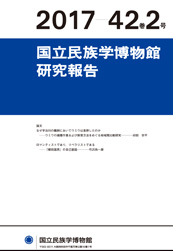Bulletin of the National Museum of Ethnology
Contents
Outline
Articles
Why Did a Japanese Cormorant Lay Eggs on Cormorant Fishing of Uji River?: A Comparative Study of Capture Techniques and Breeding Methods
Shuhei Uda
This study specifically examined cormorant fishing on the Uji River in Uji city, Kyoto Prefecture, to elucidate factors by which a Japanese cormorant unexpectedly laid eggs in a rearing house in May. No report describes a study particularly addressing cormorant breeding behavior, largely becausecormorants have never nested in rearing houses. This study examined cormorant wild cormorants in the city of Juo-cho Hitachi, Ibaragi Prefecture, and of the breeding methods used where cormorant fishing is conducted.
Results revealed the following three factors related to cormorant egg laying on the Uji River. First, cormorant fishers require large wild cormorants when purchasing birds from Juo-cho. Those large birds are more likely to be male. Second, the daily routine breeding methods of cormorants in each rearing house were examined. No nesting materials were put in the other rearing houses, where no egg laying occurred. Third, nest materials were present in the Uji River rearing house where eggs were laid before the breeding season. This study also examined reasons why Japanese cormorant fishers have never bred cormorants, although Chinese cormorant fishers breed the birds for fishing. The author concludes that different attitudes related to breeding cormorants in the two countries derive from the relative ease of capturing wild cormorants in Japan.
Key Words:Cormorant fishing, Uji River, Japanese cormorant, Great cormorant, breeding
The Making of Yanagita Kunio: From a Romantic Poet and Liberalist Bureaucrat to the Founder of Japanese Folklore Studies
Shoichiro Takezawa
Many studies have examined Yanagita Kunio, the founder of Japanese folklore studies, but few have carefully traced how Yanagita built his discipline neither folklore nor ethnology existed as an independent discipline. This lack of investigation has occurred because, from a teleological perspective, past studies have depicted the vicissitudes of Yanagita’s life to conform to the final point that he completed Japanese folklore studies.
Following his career, it is readily apparent that he constructed his academic life deliberately and independently while experiencing numerous setbacks and changes. In adolescence, he was a poet who wrote romantic poems while cultivating friendships with many novelists and poets. After studying bureaucrat dedicated to the reform of the Japanese agricultural system. In 1911, he became acquainted with Minakata Kumakusu and began pursuing ethnology and folklore studies eagerly under his influence. After World War I, he was appointed as a committee member of the League of Nations and was disappointed to witness the arrogance shown by the major powers. After he resigned and returned to Japan, he struggled to establish Japanese folklore studies. These experiences in his life made his folklore unique.
Yanagita defined his discipline around 1930 as based on four factors: distinction from adjacent science( i.e. ethnology),establishment of methodology (method of collecting data), justification for its role in society, and granting privileges to Japan as a privileged research subject. During 1925–1935 British and American anthropologists achieved radical changes in both theory and practice. Nevertheless, Yanagita, who had already completed his definition of folklore studies, never adopted them. His folklore studies became a nationalist and closed science that required no reference to neighboring sciences and foreign academic trends. In light of this past history, realizing dialogue and exchanges with adjacent sciences remains a difficult task for Japanese folklore.
Key Words:translation theory, material culture, museology, renovation, cultural understanding
 2017-Vol. 42, No. 2
2017-Vol. 42, No. 2




